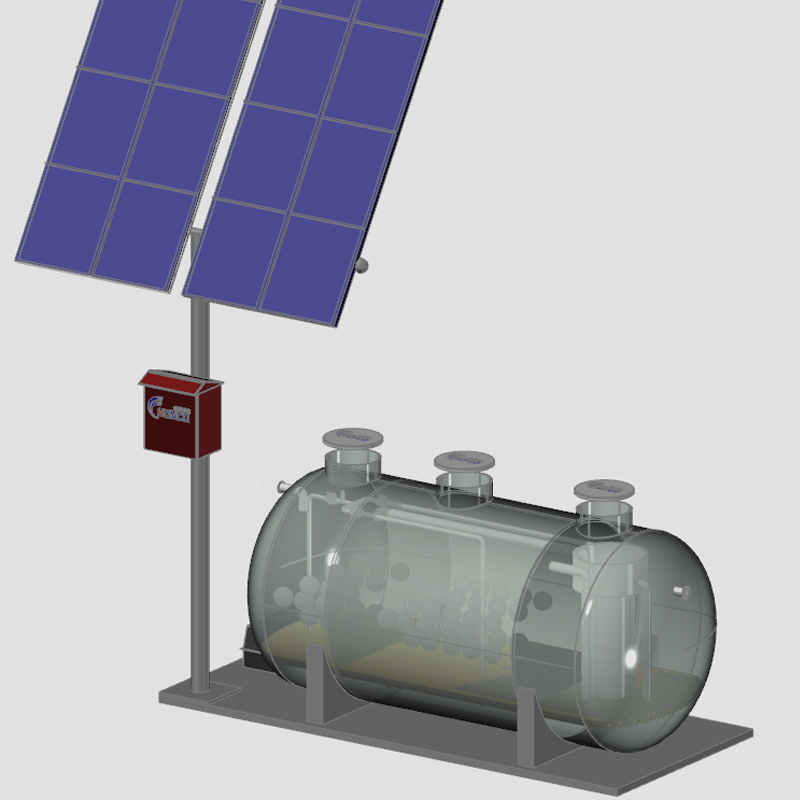Core Working Principle
The solar micro-power sewage treatment equipment adopts an innovative model of "solar power supply + biological treatment technology" to achieve efficient sewage purification.
Solar Energy Supply System:Solar energy is converted into electrical energy by photovoltaic modules and stored in batteries, providing continuous power for dynamic units such as aeration, stirring, and lifting. It eliminates the need for external power grids, completely breaking away from traditional equipment's reliance on municipal power.
Biological Treatment Process: Integrating AO (Anaerobic-Aerobic) process or MBR (Membrane Bioreactor) process, it utilizes microorganisms to degrade pollutants such as organic matter, nitrogen, and phosphorus in sewage.
Anaerobic Tank: Anaerobic bacteria decompose macromolecular organic matter to reduce the COD (Chemical Oxygen Demand) of sewage, while performing denitrification for nitrogen removal.
Aerobic Tank: The aeration system supplies sufficient oxygen, allowing aerobic microorganisms to further decompose pollutants, achieving nitrification of ammonia nitrogen and deep degradation of organic matter.
Sedimentation: Sludge is separated from clear water through sedimentation to ensure that the effluent quality meets the discharge standards.
Intelligent Control System: Integrated with a PLC automatic control system, it can adjust operating parameters in real time according to water quality (such as aeration volume and hydraulic retention time), enabling intelligent switching between "energy-saving mode" and "high-efficiency treatment".

Structural Features
Integrated Design
Compact modularization: Integrating solar energy systems, biochemical treatment units, and electrical control systems into an integrated device, with a floor area of only 1/3 to 1/2 of traditional processes. It can be installed underground or above ground, adapting to space-constrained scenarios such as rural areas and scenic spots.
Anti-corrosion and durable: The main body of the equipment is made of carbon steel anti-corrosion or stainless steel materials, resistant to acid and alkali corrosion, and the service life can reach more than 15 years.
Advantages of Solar Energy Systems
Zero electricity cost operation: The photovoltaic modules can generate 2-10 kWh of electricity per day (adjusted according to sunshine duration), meeting the 24-hour low-power operation of the equipment and saving more than 10,000 yuan in electricity bills annually.
Energy storage guarantee: Equipped with maintenance-free batteries, which can maintain the normal operation of the equipment for 3-5 days under continuous rainy and cloudy weather.
Intelligent Operation and Maintenance (Intelligent O&M)
Remote monitoring: Support real-time monitoring of water quality data (such as COD, ammonia nitrogen, pH value) and equipment operation status (such as power, aeration frequency) through mobile APP or cloud platform. It has automatic fault alarm function, which reduces the cost of manual inspection.
Performance Parameters
| Project | Indicator |
| Treatment Capacity | 5 - 100 m³/day (customizable) |
| Inlet Water Quality | COD ≤ 500 mg/L, ammonia nitrogen ≤ 50 mg/L, SS ≤ 200 mg/L |
| Effluent Water Quality | Complies with Grade 1B standard of Discharge Standard of Pollutants for Municipal Wastewater Treatment Plant (GB18918-2002), and can be upgraded to Grade 1A. |
| Energy ConsumptionSolar Power | 500W - 5kW (configured according to treatment capacity) |
| Energy Consumption | 0.1 - 0.3 kWh/m³ of sewage |
| Noise | ≤55 dB (can be reduced to ≤45 dB when the equipment is buried underground) |
| Applicable Temperature | -10℃ - 40℃ |
| Installation Method | Underground Installation/Above-ground Installation/Semi-underground Installation |
Scope of Application
Advantages:
Eliminates the need for laying complex pipe networks; enables on-site treatment of decentralized sewage, avoiding the high costs and construction difficulties of traditional pipe networks—particularly suitable for remote areas such as mountainous and lake regions.
Scenarios:
Domestic sewage in villages and towns, wastewater from agritainment facilities, pretreatment of aquaculture wastewater, etc.
Scenarios:
Tail-end standard enhancement of municipal sewage pipe networks, pretreatment of small-scale industrial wastewater (e.g., food processing and washing wastewater).
Advantages:
As a supplement to traditional sewage treatment plants, it can be flexibly deployed at pipe network nodes to improve regional water quality compliance rates.
Scenarios:
Temporary sewage discharge scenarios such as post-disaster resettlement sites, construction sites, and field operation camps.
Advantages:
Enables rapid installation and plug-and-play operation; utilizes solar power for "mains-independent" emergency treatment.
Core Advantages
Fully powered by solar energy, achieving zero carbon emissions during operation, in line with the "Double Carbon" goals.
No external power supply required. With high intelligence level, the annual O&M cost is only 30%-50% of traditional equipment.
Resistant to water quality fluctuations, capable of stable operation under complex water quality conditions such as high suspended solids and high ammonia nitrogen.
Aligns with policy orientations such as rural environmental improvement, black and odorous water body treatment, and sewage treatment in ecological protection red line areas. Eligible for environmental protection special fund support.
Choose solar micro-power sewage treatment equipment: safeguard lucid waters and lush mountains with technology, and let every drop of water become the driving force for sustainable development!